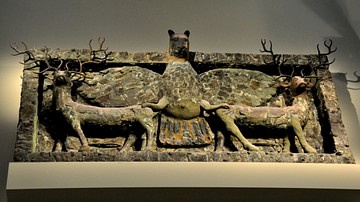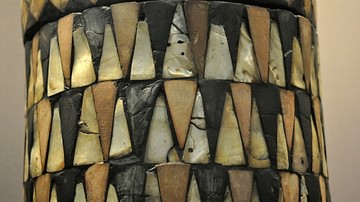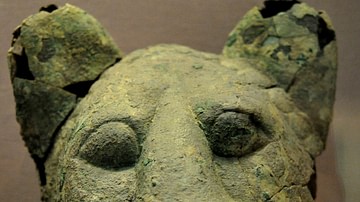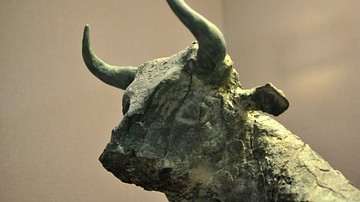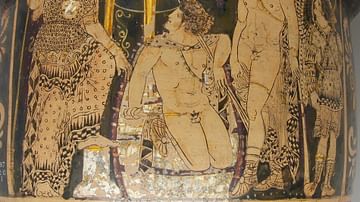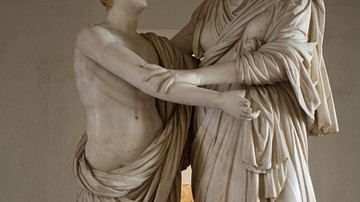Illustration
This plaque, sculpted in low relief and featuring a hole in its center, is characteristic of the period of the archaic Sumerian dynasties, from the 3rd millennium BC. The hole was probably used to attach the plaque to a wall by means of a pin, in the votive part of a temple. The decoration depicts a libation carried out by a man in ritual nudity, no doubt the king or an important priest.
The officiant pours a liquid into a tall vessel, out of the top of which protrudes a branch bearing two date clusters. The religious ceremony takes place in the presence of a fertility goddess, wearing a plumed tiara, the mark of her divinity. The goddess's function is symbolized by the palms that spring from her shoulders. She stands atop a sacred mountain, traditionally represented by a scale motif. This allows us to identify the goddess as Ninhursag, whose name in Sumerian means "the Woman (nin) of the Mountain (hursag)". She is the incarnation of the primordial figure of the Earth-Mother.
This entire scene, clearly mythological in nature, illustrates the power of religious ritual, which ensures harmonious growth for the date palm, seen as a symbol of natural fertility and prosperity. This power is seen in the goddess's intervention, whose life-generating action responds to her worshipers' religious fervor.
Louvre, Paris
References
- Visitor trails : The Great Goddess: Myths of Fertility | Louvre Museum | ParisAccessed 26 Jan 2017.
Cite This Work
APA Style
Valette, C. (2017, January 26). Libation Offered to a Vegetation Goddess. World History Encyclopedia. Retrieved from https://www.worldhistory.org/image/6298/libation-offered-to-a-vegetation-goddess/
Chicago Style
Valette, Claude. "Libation Offered to a Vegetation Goddess." World History Encyclopedia. Last modified January 26, 2017. https://www.worldhistory.org/image/6298/libation-offered-to-a-vegetation-goddess/.
MLA Style
Valette, Claude. "Libation Offered to a Vegetation Goddess." World History Encyclopedia. World History Encyclopedia, 26 Jan 2017. Web. 19 Apr 2024.

